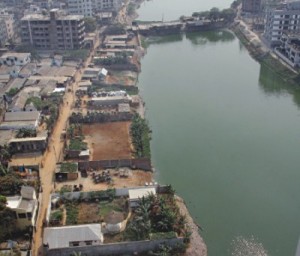Court directives not yet followed
 Instead of going by the High Court directions to protect Gulshan-Banani and Gulshan-Baridhara lakes from encroachers and restore them to their original state, Rajdhani Unnayan Kartripakkha is pursuing a scheme to conserve only whatever of the lakes are left, reports The Daily Star.
Instead of going by the High Court directions to protect Gulshan-Banani and Gulshan-Baridhara lakes from encroachers and restore them to their original state, Rajdhani Unnayan Kartripakkha is pursuing a scheme to conserve only whatever of the lakes are left, reports The Daily Star.
Rajuk however intends to acquire any genuine private land on the existing shorelines, and arrange transfer to itself of similar lands owned by different government agencies, to make only minimal adjustment to the existing shorelines under its Lake Improvement Project.
But the current widths of the lakes have been hugely narrowed down from their original sizes over the years through encroachment by earth filling.
According to Rajuk, there is a number of private land claimants on the shorelines, most of whom possess dubious documents, while some of the private lands it intends to acquire might have genuine claimants.
The court order said legal and authorised occupants within the lake areas should either be provided with alternative plots or be rehabilitated some other ways including compensations.
The lake development project is worth Tk 418 crore, of which Tk 314 crore has been earmarked for acquisition of 80 acres of land, said Rajuk sources.
The project also includes construction of walkways and driveways, four bridges over the lakes, and excavation.
The High Court in July last year directed Rajuk to survey the lakes with the help of the Directorate of Land Records and Survey (DLRS), and the deputy commissioner (DC) of Dhaka on the basis of Dhaka Metropolitan Development Plan (DMDP) to demarcate the lake areas by January 31 this year.
The court also directed Rajuk to publish the names of illegal occupants of lake areas after the survey.
Rajuk however did not carry out any fresh survey involving DLRS and the Dhaka DC office, nor did it publish any list of the illegal occupants.
It rather came up with a layout of the lakes prepared three years ago by a hired consultant, Digital Mapping Organisation, during the then caretaker government, and submitted it to the Planning Commission for the development and conservation project.
The layout was prepared taking only water-submerged areas as parts of the lake, allegedly to accommodate powerful encroachers.
The project is now awaiting approval of the Executive Committee of National Economic Council (Ecnec).
Dhaka Settlement Office under DLRS wrote a letter to the Rajuk authorities asking for DMDP designs to demarcate the lake areas.
“But Rajuk did not even entertain my officials despite several attempts,” said Dhaka Settlement Officer Faikuzzaman Chowdhury.
Rajuk’s Deputy Town Planner Abu Hasan Mortuza said they prepared designs of the lakes on the basis of the Wetland Conservation Act, and DMDP — taking mainly the water-submerged areas of the lakes into consideration.
Rajuk Chairman Md Nurul Huda said they carried out the survey without involving DLRS and the DC office because the lands of the lake areas belong to Rajuk.
Regarding publication of the list of illegal occupants, he said, “We will do it later.”
Faikuzzaman Chowdhury of Dhaka Settlement Office said, “A survey of the lake areas on the basis of Wetland Conservation Act will just show the lakes’ present status, and justify all encroachments that took place over the years.”
The HC also directed Rajuk to take immediate measures to stop any further encroachments on the lakes. But the encroachments have been going on ever since.
While unscrupulous powerful quarters ruthlessly encroached on the lakes, successive governments also allowed creation of hundreds of plots through earth filling strip by strip over the years, narrowing down the original lakes. The practice started in the 1980s, allegedly to accommodate the then ruling high-ups.
Interstingly, Rajuk itself endoresed creation of such plots over the years.
Rajuk’s Deputy Town Planner Mortuza said it is a mammoth task to reverse the allocations of plots which were done by Rajuk itself with approval of government high-ups at different times.
The Rajuk chairman said, “Whatever has been done in this regard is practically irreversible.”
The HC order came in context of a writ petition that had been filed by the Gulshan Society to protect the lakes.
Fahima Nasrin, joint secretary of the society also a former deputy attorney general, said, “Rajuk is in clear violation of the court directions.”
Shafi Sami, the society’s president also a former adviser to a caretaker government said, “We are helpless, if they do not comply with the court order.”
Rajuk prepared a combined layout of the Gulshan-Banani and Gulshan-Baridhara lakes in 1993, and a Rajuk Board meeting approved it on March 13 of that year.
Iqbal Habib, an architect of Vitti Sthapati Brindo that worked as the consultant for lakeside development during 2001 and 2002, said they considered the 1993 layout as the basis for conservation.
Following a survey of the lakes, the consultant recommended canceling allotments of 157 plots that had nothing built on them yet, said Iqbal. The consultant was later dismissed, and today almost all of those plots have structures built on them.
Rajuk also built the existing walkways in weird alignments, allegedly just to accommodate all the haphazard plots that had been created encroaching upon the lakes in collusion with some Rajuk officials.
The lakes were declared ecologically critical in 1997.
The HC directed the government to free the lakes of encrochment by August 31 this year, and to file a compliance report to the court by September 15 this year as well.




















